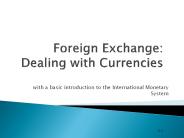Foreign Exchange Markets - PowerPoint PPT Presentation
Title:
Foreign Exchange Markets
Description:
... value of foreign-currency-denominated assets is affect by exchange rate changes. Economic Exposure: The risk that exchange rate changes may affect the present ... – PowerPoint PPT presentation
Number of Views:799
Avg rating:3.0/5.0
Title: Foreign Exchange Markets
1
Foreign Exchange Markets
2
Objectives to understand
- The organization of the Foreign Exchange Market
(FEM) and the distinction between spot and
forward markets - How to calculate forward premiums and discounts
- How forward markets can be used to reduce
exchange risk - The major participants the FEM and their motives
3
Organization of FEM
- Interbank market (95 of transactions, 20 major
banks) - Spot market 40
- Forward market 10
- Swaps 50
4
Participants
- Brokers
- Arbitrageurs
- Traders
- Hedgers
- Speculators
5
Foreign Exchange Risk
6
Foreign Exchange Risk
- Foreign exchange risk is the risk that the value
of an asset or liability will change because of a
change in exchange rates. - Because these international obligations span
time, foreign exchange risk can arise.
7
Sources of Risk
- Transaction Exposure The risk that the domestic
cost or proceeds of a transaction may change. - Translation Exposure The risk that the
translation of value of foreign-currency-denominat
ed assets is affect by exchange rate changes. - Economic Exposure The risk that exchange rate
changes may affect the present value of future
income streams.
8
Hedging and Speculating
- Hedging is the act of offsetting an exposure to
risk. - Speculation generates and exposure to risk.
9
Long and Short Positions
- People are long in a foreign currency if the
value of their foreign-currency-denominated
assets exceeds the value of their
foreign-currency-denominated liabilities. - People are short in a foreign currency if the
value of their foreign-currency-denominated
assets is less than the value of their
foreign-currency-denominated liabilities.
10
Hedging
- There are a number of instruments that can be
used to hedge foreign exchange risk. - Chapter 8 deals with the forward markets, while
Chapter 9 introduces foreign exchange futures,
options, and swaps.
11
Forward Exchange Contracts
- The market for future delivery of a currency.
12
Forward Market
- The forward market is the market for the future
delivery of a currency. - Typical maturity is 1, 3, 6, 9 and 12 months.
- The forward rate is determined by market
participants expectations of the future spot
value of the currency which, in turn, depends on
other economic variables. - Hence, the forward market may provide some
information about future spot price movements.
13
Forward Premium
- The difference between the spot and forward rates
is expressed as the standard (or annualized)
forward premium or discount. - The standard premium is calculated as the
difference between the two rates as a percent of
the spot rate, which is then annualized (simple
basis).
14
Example
- For example, suppose the spot rate is 1.6035
(/) and the 3-month forward rate is 1.6050. - The forward premium on the pound is
- (1.6050-1.6035)/1.6035(12/3)100
- 0.37
15
International Interest Arbitrage
- Taking advantage of interest rate differentials.
- Borrow Low - Lend High
- Covered interest arbitrage involves the use of a
forward contract.
16
Covered Interest Arbitrage
- Suppose the three-month Swiss franc eurocurrency
rate is 2.75 and the three-month U.S. dollar
eurocurrency rate is 5.625. - The spot rate is 1.4898 Sfr/.
- The three-month forward rate is 1.4641.
17
Covered Interest Arbitrage
- (1i) (1i)(F/S)
- The interest rates and forward rates must be for
the same period. For our example, we take the
interest rate and convert it to a quarterly rate. - So i is actually i/(12/n).
18
Example Continued
- Substitute the values into the condition
- 1(0.0275/4)1(0.05625/4)(1.4641/1.4898)
- (1.006875)(1.0140625)(0.98275)
- 1.006875 gt 0.99656
- Would you want to borrow the dollar and lend the
franc or vice versa?
19
Example Continued
- Borrow one dollar at 1.40625 for three months.
- Buy Sfr1.4898 spot.
- Lend Sfr1.4898 at 0.6875. Will receive
- Sfr1.4898(1.006875) Sfr1.5000.
- Sell Sfr1.5000 forward at 1.4641. Will receive
- Sfr1.5000/1.4641 1.02452
20
Example Continued
- Repay dollar loan at a cost of
- 1(1.0140625) 1.0140625.
- Profit of 1.02452 - 1.0140625 0.0105,
- or 1.05.
21
Covered Interest Parity
22
Covered Interest Parity
- Covered interest parity is a condition that
relates interest differentials to the forward
premium or discount. - It begins with the interest parity condition
- (1R) (1R)(F/S)
- The condition can be rewritten, and with a slight
approximation, yields - R - R (F-S)/S.
23
Covered Interest Parity
- CIP is helpful in understanding short-term market
movements. - As an equilibrium condition, it aids in our
understanding of potential adjustments in various
financial markets. - These adjustments occur if there is a flow of
savings from one nation to another.
24
Example
- Suppose the 90-day U.S. interest rate is 5.5
while the U.K. rate on a similar instrument is
5.0 (both expressed as annual rates). - The current spot rate is 1.4546 (/) and the
three-month forward rate is 1.4900. - To use the uncovered interest parity condition,
we must convert the interest rates to quarterly
values - (0.055)/(12/3) 0.01375 and (0.05)/(12/3)
0.0125.
25
Example
- Now substitute the values into the CIP condition
- 0.01375 - 0.0125 (1.4900-1.4546)/1.4546,
- 0.00125 lt 0.0243.
- Though the interest rate on the U.S. instrument
is higher than that on the U.K. instrument, the
difference is outweighed by the depreciation
(forward discount) of the dollar over the time
interval.
26
Conclusion
- Our finding for the previous example indicates
that funds would flow from the United States to
the United Kingdom. - This flow of funds would affect interest rates in
both countries, the forward exchange rate, and/or
the spot rate.
27
The Flow of Funds
- The various scenarios that are possible can be
summarized in a single diagram, the CIP parity
grid. - The CIP grid graphs the interest differential on
the horizontal axis and the forward premium /
discount on the vertical axis. - Points on a 45 degree line bisecting the grid
indicate points where UIP holds.
28
(FN-S)/S
45o
Funds Flow to the Foreign Economy
?
Previous example
R-R
Funds Flow to the Domestic Economy
29
The Flow of Funds
- The flow of funds from the United States to the
United Kingdom potentially can cause changes in
the spot rate, the forward rate, and interest
rates in both countries. - The following slides illustrate the diagrams for
each.
30
Increase in Demand for the Pound
S (/)
S
S1
S0
D
D
Q0
Quantity
Q1
31
The Spot Market
- Savers reallocate funds to pound-denominated
financial instruments. - This results in an increase in the demand for the
pound (as the demand for the pound is a derived
demand). - The demand curve shifts to the right and the
pound appreciates relative to the dollar.
32
Increase in the Supply of the Pound in the
Forward Market
F (/)
S
S
F0
F1
D
Q0
Quantity
Q1
33
The Forward Market
- Because saver are now long the pound, to cover
their position they must sell the pound forward. - This causes an increase in the supply of the
pound in the forward market, and the value of the
pound in the forward market declines.
34
Increase in the Supply of Loanable Funds in the
U.K.
R
SLF
SLF
R0
R1
DLF
Q0
QuantityLF
Q1
35
Loanable Funds in the U.K.
- As funds flow into the United Kingdom, the supply
of loanable funds increases. - This causes the interest rate to decline in the
U.K.
36
Decrease in the Supply of the Loanable Funds in
the U.S.
R
SLF
SLF
R1
R0
DLF
Q1
QuantityLF
Q0
37
Loanable Funds in the U.S.
- As funds flow out of the U.S., the supply of
loanable funds in the United States declines. - This causes the interest rate to rise in the
United States.
38
Uncovered Interest Parity
39
Uncovered Interest Parity
- UIP is a condition relating interest
differentials to an expected change in the spot
exchange rate of the domestic currency. - If foreign exchange risk is not hedged when
purchasing a foreign financial instrument, the
transaction is said to be uncovered.
40
Uncovered Interest Parity
- If a savings decision is uncovered, the
individual is basing their decision on their
expectation of the future spot exchange rate. - The expected future spot exchange rate is
expressed as Se1.
41
Uncovered Interest Parity
- Using this expression for the expected future
spot rate, UIP can be written as - R R (Se1 S)/S.
- In words, the right-hand-side of the UIP
condition is the expected change in the spot rate
over the relevant time period. - We can express the expected change in the spot
rates as ?Se.
42
Uncovered Interest Parity
- Hence, UIP is expressed as
- R R ?Se.
- According to UIP, if the domestic interest rate
is greater than the foreign interest rate, the
domestic currency is expected to depreciate over
the relevant time period.
43
Uncovered Interest Parity
- Likewise, if the domestic interest rate is less
than the foreign interest rate, the domestic
currency is expected to appreciate over the
relevant time period. - UIP can be useful in understanding why funds may
flow from one economy to another.
44
UIP as an Equilibrium Condition
- Consider the following situation
- R R gt ?Se, with both sides positive.
- The interest differential in favor of the
domestic financial instrument exceeds the
expected depreciation of the domestic currency.
In this case, and ignoring transaction costs, the
saver would be induced to reallocate their funds
and we would expect funds to flow to the domestic
economy.
45
UIP as an Equilibrium Condition
- Consider the following situation
- R R lt ?Se, with both sides positive.
- The interest differential in favor of the
domestic financial instrument is less than the
expected depreciation of the domestic currency.
In this case, and ignoring transaction costs, the
saver would be induced to reallocate their funds
and we would expect funds to flow to the foreign
economy economy.
46
UIP as an Equilibrium Condition
- The various scenarios that are possible can be
summarized in a single diagram, the UIP parity
grid. - The UIP grid graphs the interest differential on
the horizontal axis and the expected change in
the spot exchange rate on the vertical axis. - Points on a 45 degree line bisecting the grid
indicate points where UIP holds.
47
?Se
45o
Funds Flow to the Foreign Economy
R-R
Funds Flow to the Domestic Economy
48
Deviations from UIP
- To examine the performance of UIP, we can rewrite
the basic interest arbitrage equation - (1R) (1R)(Se1/S),
- As
- Se1 S(1R)/(1R).
- Se1 is then the UIP spot rate, which can be
compared to the actual spot rate that prevailed
at time period 1.
49
Example
- Suppose the the spot rate of exchange between the
dollar and the pound is 1.664 /. - The interest rate on a 3-month U.S. financial
instrument is 5.5 percent and the interest rate
on a similar U.K. financial instrument is 6.5
percent.
50
Example
- Using the formula
- Se1 S(1R)/(1R),
- the expected spot rate is
- Se1 1.664(1.01375)/(1.01625)
- 1.6599.
- Suppose the actual rate is 1.60. UIP, therefore,
indicates that the pound is undervalued.































